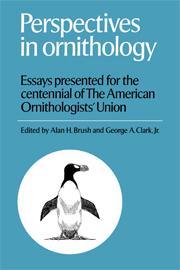 Perspectives in Ornithology
Perspectives in Ornithology Book contents
- Frontmatter
- Contents
- List of contributors
- Preface
- Introduction
- 1 Captive birds and conservation
- 2 Research collections in ornithology – a reaffirmation
- 3 On the study of avian mating systems
- 4 Cooperative breeding strategies among birds
- 5 Ecological energetics: what are the questions?
- 6 Perspectives in optimal foraging
- 7 Biochemical studies of microevolutionary processes
- 8 Organization of the avian genome
- 9 The origin and early radiation of birds
- 10 Avian community ecology: an iconoclastic view
- 11 Biogeography: the unification and maturation of a science
- 12 Bird song learning: theme and variations
- 13 Bird navigation
- Index
2 - Research collections in ornithology – a reaffirmation
Published online by Cambridge University Press: 04 August 2010
- Frontmatter
- Contents
- List of contributors
- Preface
- Introduction
- 1 Captive birds and conservation
- 2 Research collections in ornithology – a reaffirmation
- 3 On the study of avian mating systems
- 4 Cooperative breeding strategies among birds
- 5 Ecological energetics: what are the questions?
- 6 Perspectives in optimal foraging
- 7 Biochemical studies of microevolutionary processes
- 8 Organization of the avian genome
- 9 The origin and early radiation of birds
- 10 Avian community ecology: an iconoclastic view
- 11 Biogeography: the unification and maturation of a science
- 12 Bird song learning: theme and variations
- 13 Bird navigation
- Index
Summary
Organized assemblages of natural curiosities presaging research centers first emerged in Europe in the sixteenth and seventeenth centuries. Small natural history museums and personal collections of this time were used primarily by a small group of scientifically pioneering amateurs. The first natural history museum open to the public was founded at Oxford, England, in 1683, followed 70 years later by the establishment of the British Museum in London. In North America, Charles Wilson Peale created the first natural history museum in the 1780s, in Philadelphia. Later additional Peale museums were established in Baltimore and New York. These museums failed in the 1820s after Peale's death, because of his emphasis on profit rather than perpetuity. Nonetheless, with zoological specimens arranged according to the Linnean classification, Peale's museums set the tone for the major research institutions founded later in the nineteenth century.
In the 1850s, Spencer Fullerton Baird, at the Smithsonian Institution, was faced with an immense influx of specimens from explorations in the American West. He realized that a U.S. national museum “would both increase public knowledge of fauna and flora and provide scholars with comparative material for biological research” (Alexander 1979:51). The dual purpose of museum collections has been echoed many times.
- Type
- Chapter
- Information
- Perspectives in OrnithologyEssays Presented for the Centennial of the American Ornitholgists' Union, pp. 37 - 54Publisher: Cambridge University PressPrint publication year: 1983
- 4
- Cited by


